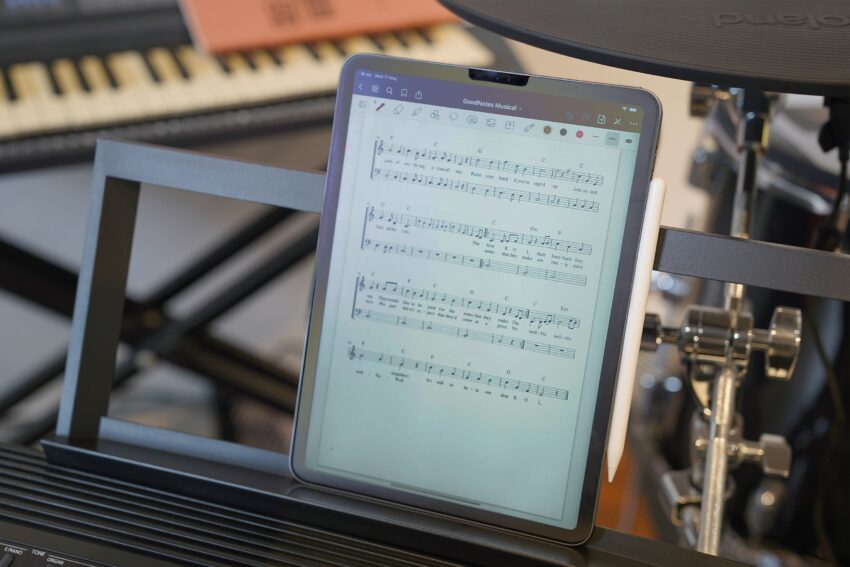For the modern musician, an iPad can be a great way to view and manage sheet music. In fact, among professionals and amateurs, alike, there is a fast-growing trend of musicians using iPads for sheet music instead of paper music. In this article, we’ll cover some of the main reasons why musicians are making the switch to using an iPad for sheet music, and some helpful pointers to keep in mind as you make the switch yourself.
Why use an iPad for Sheet Music?
There are many reasons why you might want to use an iPad for sheet music, instead of traditional paper scores.

Travel Better
One of the main reasons why you might want to use an iPad for sheet music is so that you can have all of your music with you at all times. Even the most basic iPad can store a lot more music than a binder or folder can, so you can have all of your music at your fingertips when you need it. With an iPad, you can easily store and organize all of your sheet music in one place, so you don’t have to worry about losing any of your music or having to carry around a lot of paper.
Speaking of carrying around a lot of paper, another compelling reason to use an iPad for sheet music is that it can help lighten your load. The iPad is a more portable and convenient option for scores than conventional paper-filled binders, plus there are many apps available that make it easy to store, organize, and manage sheet music on an iPad. If you’re carrying around a lot of paper music, an iPad can help you save space and weight. This is important for musicians because their bodies need to be in good condition to perform their best.
Save Trees
Another reason to use digital sheet music is that it can help you save on paper and be more environmentally friendly. If you’re using digital sheet music, you don’t need to print out copies for yourself or your collaborators who also use iPads. This can save a lot of paper (and money!) and help reduce your carbon footprint.

Keep in mind that you’ll need to make sure you have copies of the music for collaborators who are not digital. It’s easy to forget about this if nearly everyone in your group is using an iPad, but it’s essential to make sure everyone has what they need to participate.
Keep it Fresh
Keeping a digital music library on your iPad means that you are only ever a few taps away from a clean copy of your scores. While written notes are crucial as musicians learn pieces and prepare for performances, it’s important to be able to share copies that are free of markings with collaborators or students.
Stay Current
Using an iPad for sheet music can help you keep up with new content. If you’re a musician who likes to try new things, you can easily find and download new sheet music on your iPad without the hassle of printing scores. Digital sheet music is also easy to share via email, Bluetooth, or even text message! (Just make sure you’re following any applicable copyright laws.) By using an iPad for sheet music, you’ll always have the latest and greatest music at your fingertips.
Helpful Hints for Using an iPad for Sheet Music
As you move into the world of digital scores, there are a few different apps you can use. One popular option is ForScore. This app is used by many professional musicians and has a lot of features to help you manage your music.
As you switch to digital sheet music, you’ll also want to know how to mark your scores. On an iPad, you can easily make changes and markings on your music without having to print out a new copy. Many apps allow you to annotate your sheet music. This can be done in a number of ways, but one popular method is to use a digital pen. You don’t need an Apple Pencil to use an iPad for sheet music, however, an Apple Pencil is more precise than a regular stylus for annotating or marking up scores.
Always charge your devices before you leave for any performance or rehearsal! It might be wise to carry a portable battery, as well, in case an emergency battery situation arises.

Finally, if you are performing with a group, confirm that your iPad can be used in performance. Most conductors may allow you to use an iPad onstage, but it is always best to check with the conductor in advance. There may be exceptions based on lighting considerations or copyright concerns.
In conclusion, iPads are fantastic tools for sheet music and can be a great way to save time, paper, and hassle. If you’re a musician, it’s definitely worth considering using an iPad to manage your music.
Looking for a place to test out your new digital music library? Try joining a virtual choir!
